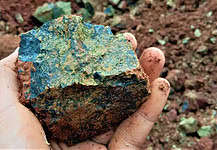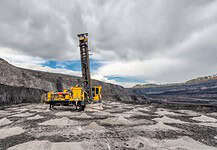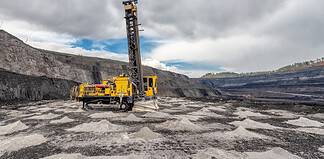All images: Gold Fields Australia.
BY REUBEN ADAMS
CONSTRUCTION work is ramping up at the $532 million Gruyere gold project, 200km east of Laverton in WA. For South African-based Gold Fields, which holds a 50 per cent stake in the project with Gold Road Resources, Gruyere represents the newest chapter in a long, influential – but relatively low profile – history in the WA gold sector.
A January update has underscored the massive scope of this 270,000 ounce per annum (ozpa) project, which remains on budget and on track to pour first gold in early 2019.
In the December quarter, the Gruyere JV awarded a key five-year, $400 million mining services contract to Downer EDI Mining, which will begin construction of mining infrastructure in the March quarter.
MACA Civil has continued to make strong progress on the bulk earthworks, completing the 28km Gruyere main access road, sealed airstrip and clearing for the Stage 1 Pit and Tailings Storage Facility (TSF).
More than 4200sqm of concrete has been poured by EPC contractor Amec Foster Wheeler Civmec Joint Venture (ACJV) in the process plant area; and a further 10,500sqm is to be poured before the process plant is complete.
Construction of the seven carbon-in-leach tanks is progressing to schedule, with the floor and annular plates for the tanks transported to site from Civmec’s Henderson facility, and welding had commenced on these tanks during the December quarter last year.
Delivery of the first structural steel for the process plant is scheduled for the March quarter, as is delivery of the ball mill components, which are currently undergoing final inspection in Perth.
Separately, APA Group received final approval for the Yamarna Gas Pipeline (YGP).
APA will design, build, own and operate the 198km pipeline and a 45 megawatt gas-fired power station to supply power to Gruyere, at a total cost of about $180m.
Gold Fields: A WA mainstay
For Gold Fields, Gruyere will tip annual production from its WA mines over the 1 million ounce per annum mark.
Currently, Gold Fields is the second largest gold miner in WA, and the third largest Australia-wide. It has been a WA mainstay for 17 years, producing about 900,000ozpa from its three WA mines: St Ives, Agnew, and Granny Smith.
These operations provide about $343m of cash flow and employ 2200 staff and contractors. Results for 2017 are also expected to be very positive.
And yet the company – which is listed on the NYSE and JSE – has traditionally flown under the radar in Australia.
Gold Fields Australia boss Stuart Mathews said the company had recently committed to boosting its public profile.
“WA is very important to the company. I’ve made it a mission of mine as the EVP for the region to lift our profile, so that people know who we are through engagement with Local and State Government, and by speaking at more forums like the Mining Club,” Mr Mathews said.
“It is significant what we are doing here. We are currently underselling ourselves a bit I think – we have a good story to tell.”
For Gold Fields, the 50 per cent buy-in to Gruyere will add substantial life to the miner’s production profile.
Gruyere boasts a 13 year life on present reserves, but the JV partners expect it will grow well beyond that.
Mr Mathews said often there had been criticisms of short life of mine from investors and analysts in Australia, which was not necessarily justified – companies must invest in growing reserves at the right level to keep themselves sustainable.
“For instance, at Agnew [gold mine] people would say say ‘well, you’ve only got three or four years of reserves left’,” he said.
“That’s true – but Agnew has had three or four years of reserves left for 35 years, and there’s still no end in sight.”
Justified or not, Gruyere has helped Gold Field’s life of mine story, and it will take the miner to over 1mozper annum in Australia alone.
But the highly prospective wider tenement package also it provides the miner with longer term growth options.

The Golden Highway
The benefits of the Gruyere JV lie beyond the initial 270,000ozpa operation and into the exploration potential of the project’s surrounding area.
Gold Fields has a history of defying trends in exploration.
For the past three years the company has sunk $100m annually into exploration across its Australian assets.
“It’s always the same – when commodity prices are in the doldrums usually exploration is the first casualty,” Mr Mathews said.
“We took a view that this was the time for us to invest heavily. We wanted to shift the dial a little bit in Australia, so it’s part of an initial five year program of investment.”
In 2017, that $100m represented about one third of the total gold exploration spend in the whole of Australia.
The exploration program is now beginning to see real rewards.
“It just proves that even though we have been on these big tenement packages in Australia for a long time, they are still yielding results for us which will keep Gold Fields sustainable for a long time,” Mr Mathews said.
While its focus is on bringing Gruyere into production, the miner is co-funding further exploration at Gruyere to the tune of $5.5m, part of a total budget of $11m for the 2017 year. Exploration investment at Gruyere will continue going forward.
Gold Fields took a 10 per cent stake in Gold Road in May last year, a company which also has a history of exceptional exploration success.
Gold Road will be spearheading the exploration program on the Gruyere JV tenements, which involves a program of diamond and RC drilling along the so-called Golden Highway.
The Golden Highway is a 14km long and up to 90m wide zone of anomalous gold defined by grades greater than 0.1 grams per tonne (g/t) occurring within the Attila-Alaric Trend.
A December exploration update confirmed a number of deposits along the 14km trend had the potential to add significant value to the project – extending its life well beyond the initial 13 years.
The best intersection returned from the recent drilling was at Montagne with an intercept of 8.47m at 15.38 g/t of gold from 56m.
A detailed IP survey was also recently completed over the full extent of the Attila-Alaric trend, which will assist in defining the extent of the gold mineralisation.
Recruitment: a skills issue
A resurgent mining sector always highlights labour market pressures as skill shortages begin to emerge – a problem that Mr Mathews said required long term solutions.
“I think most companies would be worried about the level of people entering universities and taking up subjects relevant to the mining industry,” he said.
“It doesn’t help that new commodities like lithium and cobalt are taking off, which is going to put even more pressure on getting quality people.
“The problem is that people leave mining during the downturns and do other things – and they don’t come back.
“There’s always a lot of talk about mining downturns, so as a young person with a view to go into the mining industry – engineering, geology, or environmental science – you’ll probably think twice.
“We have to try and make mining a bit more attractive again.”
It’s a debate that many miners would be having at a management level.
Gold Fields are going to be here for a long time, and so the miner must start “deep diving” in skills, Mr Mathews said.
“We aren’t just talking about being a mining engineer, or a geologist or metallurgist anymore – we have great jobs in finance, in community relations, business engagement, and all sorts of sustainability projects that people don’t realise,” he said.
“We need to think about giving people career options at a low level before they even consider going to university, even at high school level.”








































